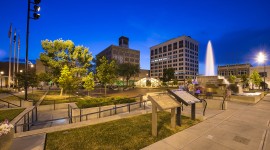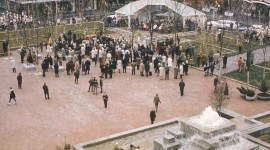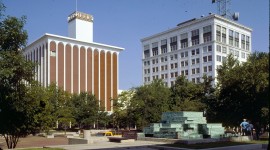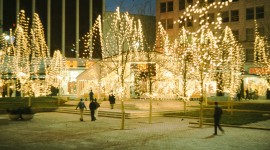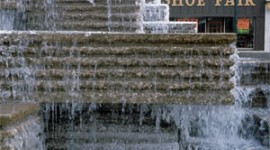Forgotten Halprin-designed Park Central Square at Crossroads
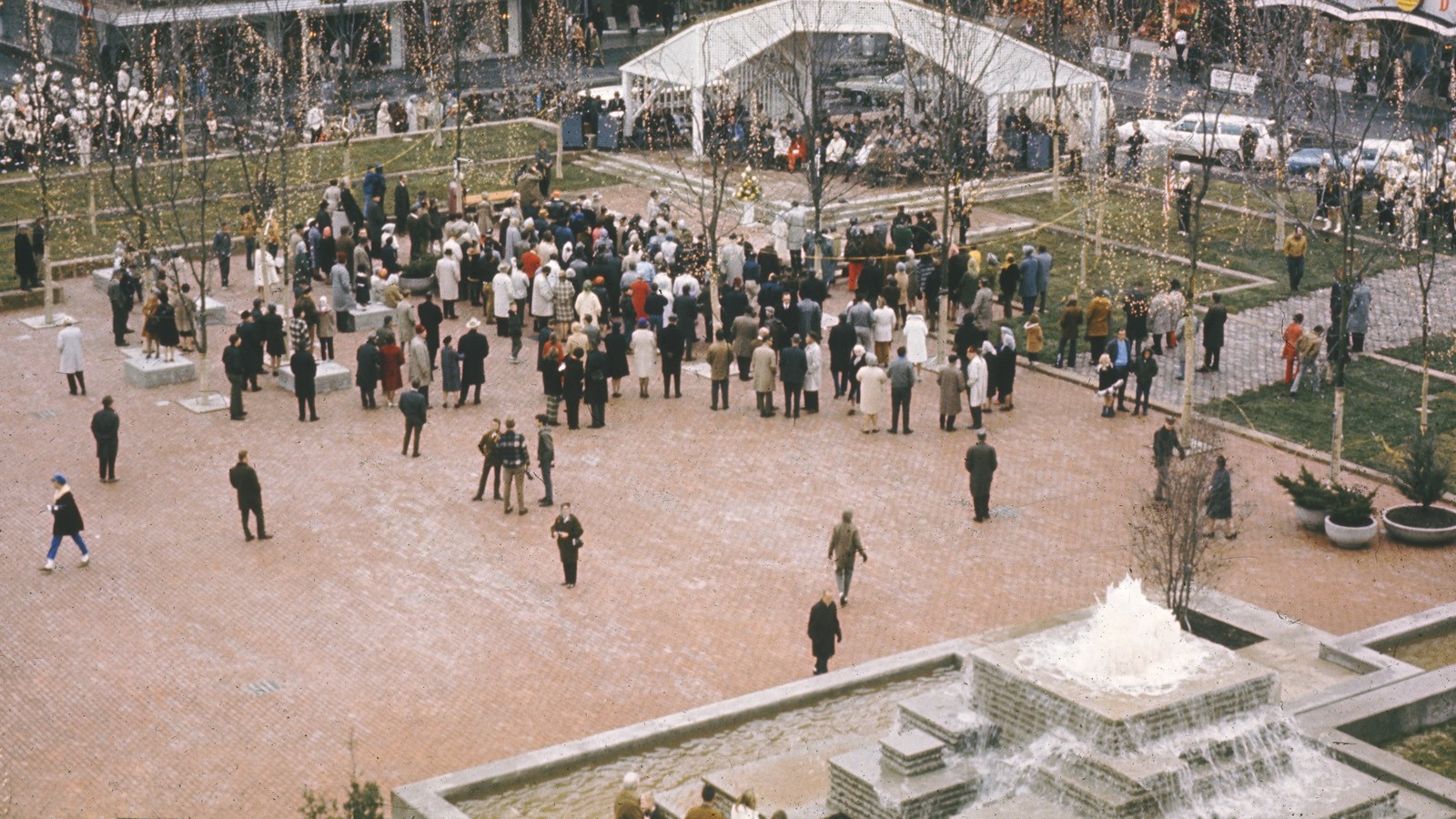
In response to proposed major changes, longtime Springfield, Missouri, resident, Ruth Kelley, ignites discourse for forgotten Halprin-designed park.
Editor’s Note
The ongoing care and management of public spaces often begins with the voice of one or two people who recognize the value that a well-designed public landscape offers their community. On occasion, they take the time to speak out because they value the continuity with the past, and in the process they remind others of the benefits of preserving, rehabilitating, and interpreting spaces which celebrate their regionally specific civic history. Such advocates can also remind the community of the many ways in which a particular design has been enjoyed, and in the process, may reveal its forgotten history (e.g. that it was the work of a master landscape architect). Such sympathetic eyes may also recognize that there are ways to celebrate its design and to make changes in a way that is respectful of the original intent of its designers and patrons.
Project Updates
May 23, 2008
On May 23, 2008, the Missouri State Historic Preservation Office (SHPO) notified the City of Springfield that Park Central Square was determined eligible for inclusion in the National Register of Historic Places. The decision followed a teleconference held May 14, as part of a Section 106 review in which representatives from the Springfield government, the Department of Transportation, the National Trust for Historic Preservation and TCLF participated. As a result of the Section 106 review, the Missouri SHPO also determined that the proposed alterations to the Halprin-designed square would have an ‘adverse effect’ on the historic property. This determination means that Federal funds cannot be used to achieve the current plan iteration during the Phase I portion, however, does not mean that the square is protected, as the Springfield News-Leader reports there is discussion within Springfield to privately raise the $1 million needed to fund the proposed plan which has already been approved by the City Council .
As a result of the adverse effect determination, the city will reallocate the Federal Highway money to begin construction of Phase II plans to improve and widen sidewalks and lighting while contemplating what to do regarding the square proper and working with the Federal and State agencies to achieve a solution.
February 13, 2008
On Wednesday, February 13, 2008, the News-Leader in Springfield reported that “The Springfield City Council approved a redesign of Park Central Square on Tuesday, despite concerns by some — including a councilman — that it disregarded the vision of the nationally recognized architect who designed it.”
With less than two days notice prior to that meeting, the Cultural Landscape Foundation submitted a letter to the Springfield City Council members in the hope that the historically significant design by landscape architect Lawrence Halprin could inform the public process. At the hearing, Springfield Mayor Pro Tem Gary Deaver stated that "it's a bit late to be coming in and trying to change the game."
A lone council member, Dan Chiles, who had been in touch with Halprin, disagreed. Chiles stated that he wasn't ready to alter a city landmark without first talking to the designer. He went on to note that, "it's hard for Springfield to distinguish itself from the 30 other Springfields," and that "we shouldn't be remembered for being the one that bulldozed a historic landmark."
The News Leader quoted a local developer, Scott Tillman, who is building the College Station project west of the square, that “ he would liked to have known about Halprin six months ago". The Heer's Building developer, Kevin McGowan of St. Louis, states in an e-mail to a city official that, "As a favor to Springfield I closed on this building ahead of necessary commitments I would need from Springfield in order to go forward with the development of Heer’s. This building is costing Blue Urban thousands of dollars a day and any delay will cost Blue Urban more. Please impress upon the Council any delay adds peril to this project. The Square is necessary for Heer’s but more necessary for Springfield."
Although the project consultants suggested that Halprin’s involvement was noted at the project’s onset, and that there has been significant public opposition to the project, which according to the News-Leader is 3 to 1 in opposition, the proposed redesign has been rubber stamped by the Council Members.
TCLF continues to continue to work with National and local partners in the hope that the proper procedures are followed as this work advances that would have an adverse affect on this once forgotten historic designed landscape.
Background
On December 15, 2007, Mrs. Ruth Kelley, a long-time property and business owner in downtown Springfield, Missouri, wrote a letter which appeared in the local newspaper, the News-Leader. In that communication, she asked the city council to reconsider the proposed reconfiguration of the Park Central Square, in downtown Springfield. She opened her passionate plea asking the question: “Would you discard a painting by Fredric Remington? Our Park Central fountain was designed by America's foremost landscape artist, Lawrence Halprin of San Francisco.”
Her heartfelt letter was picked up on a “Google Alert” by Brice Maryman, a Board Member of The Cultural Landscape Foundation. Maryman, a fellow Halprin devotee who has been involved in Seattle’s Freeway Park (Halprin, 1976) sent it on to our office. We were intrigued with this undocumented early public project by Halprin – a design that does not appear in any of the early surveys (e.g. Process Architecture No. 4: Lawrence Halprin, 1978.) We immediately contacted Mr. Halprin who sent the images that accompany this Landslide feature (see also the sidebar for his personal recollections). Concurrently, we contacted Mrs. Kelley and asked her to tell us more about Park Central and its meaning to the citizenry of Springfield, Missouri. Here is her response:
"Springfield is Missouri ’s third largest city and is in the southwestern part of the state. We who live here call it “Queen City of the Ozarks” since we are a gateway to a recreation area for visitors to enjoy lakes, hills, rivers, and entertainment of many kinds. The town was established about 1830 and land in its center was designated as a public place by the founding Campbell family. It has been used in many different ways for people to gather whether by mule, horse and buggy, wagon, and later, automobile parking.
Around 1970, the area was given park status with local people asking Lawrence Halprin to design it as a memorial to the Dorsey Heer family, and it was accomplished by 1974. Its most prominent feature is a structure located on the east. This beautiful multi-level stone fountain with water flowing into a shallow basin beneath it, somewhat of a Halprin signature, I think, is similar yet smaller than the one he designed in Portland, Oregon. It is appealing for children to play in the water and for others to sit on the stone edges. No matter the age, it is beautiful all year long.
The plaza is paved and has multiple uses and a low wall around it to give it the feeling of an entity in itself. On the northwest corner is a gazebo given by the Cooper family as a memorial to Harry Cooper. It can be used for sitting in for shade. Also for shade there are about a dozen trees to enhance the Park’s beauty. There are also large concrete planters for flowers in different places.
The combining of the beauty of the sky, the trees and flowers with the enhancing serenity for the sound of water, the colors of the brick, the forms of the gazebo and sculpture add up to a pleasant, relaxing time of sitting or walking in or around our square. We can all be grateful to the people who funded it and to Lawrence Halprin for his design genius.
As a central location to our rapidly growing city, its tranquil and open environment offers more than an aesthetic contribution. Throughout the year, there are many events held downtown, some of which hold their “headquarters” within the square. The versatile structure makes it a useful place for the many organizations wishing to utilize this space.
The southwest corner has a metal structure given to memorialize another descendant of a founding family, Harve Fulbright. It can be appreciated for its contemporary style of art. All in all our Park Central Square designed by Mr. Halprin is a haven in the center of our city to enjoy the nature and the people.
There is discussion about major changes to the park. The City Government has a contract with an architectural firm for work to be done. It has happened at present because a major downtown building, just east of the Park has been purchased from the City by a developer from St. Louis who plans to build loft condos for the upper floors with a restaurant and shops on the lower levels. He specified that “fixing up” Park Central Square was part of the plan. Changes have yet been finalized.
When I talked to people in City Government about why this came about I did not receive a clear answer. I was told a million dollar grant had been requested and received for changing the Square. Last fall there were public hearings about what to do, with many contradictory suggestions as to traffic shape, purposes and appearance. Few have been aware that it was designed by Lawrence Halprin or of his reputation as a nationally acclaimed public spaces landscape architect.
I think it would be a mistake to change this beautiful park and most of the people who have responded to my letter to the editor agreed. They did not want this and don’t understand how it has came about. Just today an employee mentioned how she enjoyed her time witnessing an exhibit on a spring day. I hope it will not be demolished or drastically changed to concur with a potential developer’s wishes for change. Major change is not necessary in order to keep this park a vital contribution to the Springfield community."
- Ruth Kelley lives in Springfield, Missouri, and through the work of her landscape-architect daughter, became aware of the origins of the fountain.
Halprin reflects on his firm’s design for Park Central Square
During a recent conversation with Lawrence Halprin, TCLF President, Charles Birnbaum asked the landscape architect to reflect on his firm’s designs for Park Central Square. Here is what he recollected:
"This work came after the firm was already consulting in Missouri (referencing the Civic Center Master Plan for Kansas City of 1966). The design for Springfield came about as shopping malls such as Nicollet Mall in Minneapolis, MN, were gaining popularity. These public spaces were also becoming cultural centers, with art becoming widely incorporated. The fountain at Springfield was meant to present abstraction and it had a lot to do with design. Architect Charles Moore [who had worked with Halprin on Lovejoy just a few years earlier with Moore & Turnbull as associated architects] likely influenced the Pavilion design, including its clipped corners."
How to Help
Send a letter requesting full consideration of the Lawrence Halprin design to:
Missouri Alliance for Historic Preservation
The Springfield News-Leader print editor
Reader’s Comments
Devin A. Colman from Burlington, Vermont
Posted: January 24,2008
"I was fascinated to read about the Halprin-designed park in Springfield, MO. I lived in Springfield for a short time a few years ago, and always thought the park was an interesting example of 1970s landscape design. Little did I know that it was by Halprin! Springfield is a quirky place and is seeing major changes, both good and bad. The historic downtown is thriving, but sprawl at the edge of the city continues to grow too. The Halprin park anchors one end of the historic Main Street district and is a key part of the downtown area.”
I really want to encourage TCLF to get involved in saving this park. It's a great asset to the City of Springfield, which has precious few extant examples of modernist architecture or design."




